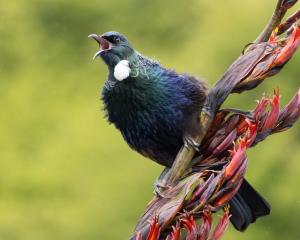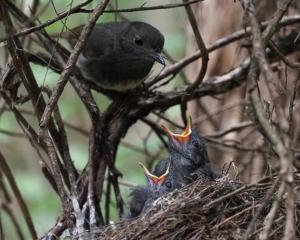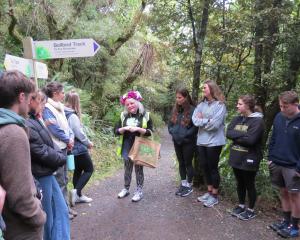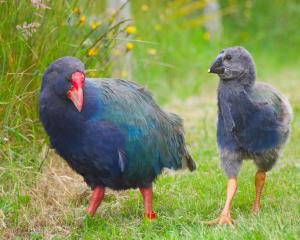The tuatara reintroduced a few months ago into a Dunedin forest are posing some interesting questions for researchers from the University of Otago, as Neville Peat reports.
Well off the beaten track at Orokonui Ecosanctuary is a precinct that in olden times might have been mapped with a warning to adventurers: ''There Be Dragons!''.
Spiny-backed tuatara, which belong to an ancient reptilian group that first appeared about the same time as dinosaurs, look like miniature dragons, and in some ways they are as mysterious as mythical dragons.
Not surprisingly, a group of zoologists from the University of Otago is undertaking a study of the Orokonui population, which includes animals newly introduced from Takapourewa (Stephens Island) in Cook Strait and Nga Manu Nature Reserve at Waikanae with the blessing of the Maori guardians or kaitiaki of tuatara, Ngati Koata.
The study involves three groups of juveniles, 26 altogether, all of which are carrying transmitters - 10 wild-collected young ones from Stephens Island, 10 captive-raised juveniles from Nga Manu, and six from Orokonui itself, reared in an enclosure over the past three or four years. The transmitters are attached by an elastic backpack and weigh four grams.
All 26 were released late last year into prepared burrows in a forest setting and can now roam free, along with adults and other juveniles, in a population of 87. Some monitored adults laid eggs within a month or two of arriving at Orokonui - the first known tuatara nesting in the wild on the South Island for hundreds of years.
Tuatara are long-lived animals. Some could reach 100 years of age. They do not breed until they are about 13 to 20 years old. The gravid females will dig a special nest chamber, lay about 10 eggs then cover over the chamber. Soil and climate do the rest.
Warmer soil temperatures will produce male young; cooler soils female young. As Orokonui is the southernmost and coolest location for free-roaming tuatara in modern times, there is intense interest in whether the site will produce more females than males into the future. Of immediate interest, though, is the largely spatial study of the juveniles with transmitters.
The field work is being led by master's student Scott Jarvie.
A former Department of Conservation biodiversity ranger, he handled tuatara on an island sanctuary off the Whangarei coast and has had assignments ranging from subtropical Raoul Island to the subantarctic Antipodes Island. Jarvie is radio-tracking the juveniles intensively for five months, twice a week, until March, and will keep track of smaller numbers over winter.
He says the dispersal patterns of the wild-collected animals compared to the captive-reared ones will be reported to the Department of Conservation and Ngati Koata, and the information will feed into future translocations that are part of the recovery plan for tuatara. Wildlife managers overseas are also going to be interested in the results of the study.
''There have been concerns raised that captivity may decrease the ability of individuals to survive when introduced into the wild.''
Jarvie's study will investigate whether individuals in the three groups (Stephens Island, Waikanae and Orokonui) gain or lose weight, how far they disperse, and the kinds of habitat they choose. By December he had completed about two months of monitoring and recorded the longest movement between tracking visits as 24m, that of a wild-collected juvenile. Most juveniles, however, had moved only a few metres, if at all, and they were all within 30m of their release burrows.
''We really can't predict what movement and other behaviour will occur because Orokonui is so different from other translocation sites.
''It's a curious thing to be working with an animal that could well live as long as you.''
His primary supervisor is the head of the department of zoology, Associate Prof Alison Cree. Dr Cree has been working with tuatara since 1986, when she first visited Stephens Island. Associate Prof Philip Seddon, director of wildlife management at the university, is co-supervising Jarvie's study.
Given the iconic status of tuatara, Dr Cree believes the study will be of great interest to Orokonui's large community of supporters and the public generally, as well as to conservation scientists. She paid tribute to Orokonui's tuatara caretakers, including Valerie Fay, a volunteer.
Orokonui is a mainland ''island'' surrounded by a predator fence and is an ideal place for tuatara to forge a new presence. Subfossil records show they once lived in coastal Otago.
A captive-reared pair from Southland Museum is on show at a specially-built viewing pen near the main gate. In years to come visitors may happen upon some of the free-roaming tuatara on the walking tracks - modern mini-dragons.
Neville Peat is a trustee of the Orokonui project.












